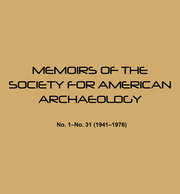No CrossRef data available.
Article contents
V. The Conclusions from the Experiment
Published online by Cambridge University Press: 27 June 2018
Extract
In this experiment, the frequencies of occurrence of prehistoric cultural traits have been used to evaluate various alternatives of the process of sampling a hypo the tic ally unknown region. The sampling process is manifestly useful in archaeological survey.
The experimental results are only as valid as the methods, data, and theory on which the results are based. The sampling theory has been presented in Chapter III. Therefore, a synopsis of the research methods of the Paria Plateau survey is presented in this section so that the reader can continue to evaluate the data and the results of the experiment.
As frequently happens in contract archaeology, the topic of this experiment was formulated after the completion of the fieldwork. Therefore, the experiment depends on data that were collected to solve non-sampling problems. If the problem of this study had been conceived prior to fieldwork, it would have been possible to collect interval level data (such as the area of the site, of surface refuse, and of dwelling units) and to perform controlled, probabilistic surface collections. This would have added 2 interval variables—artifact and debris densities—and allowed for the employment of more powerful statistical tests.
- Type
- Research Article
- Information
- Copyright
- Copyright © Society for American Archaeology 1974


